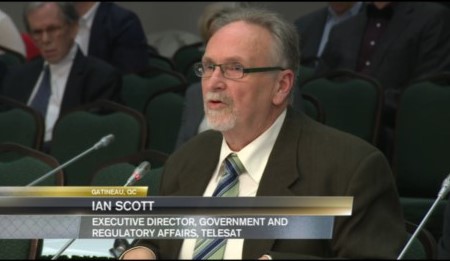
GATINEAU – The first two days of the CRTC’s basic service objective (BSO) hearing had a distinct northern flavour. Witnesses argued that a lack of backbone capacity was hindering broadband in the region. On Wednesday, two companies intimately involved with satellites appeared before the Commission, arguing that new birds coming online within the next year will help address capacity constraints for rural and remote regions of the country.
Satellites have long been a key part of the broadband solution for the Far North, but in some ways the hype didn’t meet reality. As the Commission heard during the first two days of the BSO hearing, there are many remote and northern communities with broadband services of significantly lower quality than urban Canadians enjoy. Still new, higher capacity satellites are coming online in the next year that will bolster northern bandwidth.
Telesat noted in its appearance that current generation of high throughput satellites (HTS) have 30 times more capacity than conventional birds. Newer generations of satellites will have 100 times more capacity and a little further in the future this capacity will increase to 400 times. For example, the company’s Telstar 19 Vantage will have more than 20 Gbps of throughput capacity available to the North.
The advantage of these new satellites, explained Ian Scott, executive director of government and regulatory affairs (pictured), is that in addition to having significantly more capacity, they will offer it at a lower cost. He described these types of satellites as “a game changer” for the North.
With all this new capacity hitting the skies in the not so distant future, Telesat believes it’s time the Commission make broadband a basic service. “HTS in particular, used both in a community aggregation and direct-to-home model, will help ensure that sufficient broadband capacity is available in the North. HTS will be capable of delivering much higher broadband speeds at prices much closer to what is available in the south,” said Scott.
Xplornet Communications, a big satellite capacity user, also highlighted higher capacity satellites as a solution to broadband in the North. But it also noted that its fixed wireless LTE network is being expanded, too. The latter is currently being rolled out in a number of regions offering households 25 Mbps service. The satellites will offer comparable speeds once operational.
Company representatives added that given the evolution of the Internet over the past five years, it now makes sense to establish a basic Internet service that should be available to all Canadians and suggested a 5 Mbps offering would fit the bill.
Allison Lenehan, president and CEO at Xplornet, noted that this level of service would provide Canadians with what they need, but not necessarily all that they want. He said a basic service would include the ability to do email, electronic banking, update software, educational purposes, health and government services.
“Playing real-time video games, or, replacing your TV service with video streaming, are ‘wants’, not ‘needs’. Canadians want these services. As an industry, we are investing to meet this market demand. But they are not a necessity,” he said in his opening remarks.
CRTC chairman Jean-Pierre Blais noted in his opening address to the hearing on Monday that the distinction between needs and wants will be examined closely during the 14 days.
“We are indeed thinking that the primary issue is that if you create just a cheap package, its a rather blunt instrument to try and get at the affordability issue.” – CJ Prudham, Xplornet
With additional satellite capacity on the horizon and wireless technology being rolled out, it may seem like Xplornet has everything it requires. That’s not the case however, as its use of wireless grows, its needs for more spectrum increases too. Tim Denesen, executive VP of networks, noted it relies to a large degree on scarce licensed spectrum.
“In order for us to make the investments in any fixed wireless infrastructure we do need to have access to licensed spectrum preferably,” he said. “It gives us the longer term ability to make the investment and secure the fact that we can get customers.”
The company acknowledged that in rural and remote areas, it may be more than just lack of capacity that determines whether a household has a broadband connection. Xplornet proposed a new way to ensure that low-income families can get the basic minimum service. It suggested a targeted initiative to identify and fund these households be undertaken by the federal government.
Under questioning, CRTC chair Jean-Pierre Blais, wondered why this has to be done at the federal level. CJ Prudham, executive VP and general counsel, noted that the provincial and municipal governments can do some of this too, but the important thing is to ensure that households that need funding get it.
“We are indeed thinking that the primary issue is that if you create just a cheap package, its a rather blunt instrument to try and get at the affordability issue. You might have a lot of people taking advantage of it who are not necessarily in need, when what’s important is we get the folks who actually need assistance,” she said. Prudham added this has to be seen holistically in that it involves making sure people need assistance, but then can also get a computer and receive digital literacy skills.
The BSO hearing continues Thursday and Friday with a number of groups arguing for more affordable broadband appearing. The Federation of Canadian Municipalities is also scheduled to appear. The CRTC is offering an audio stream on its web site and you can watch the hearing on CPAC.ca (which is where we obtained our screen cap).



